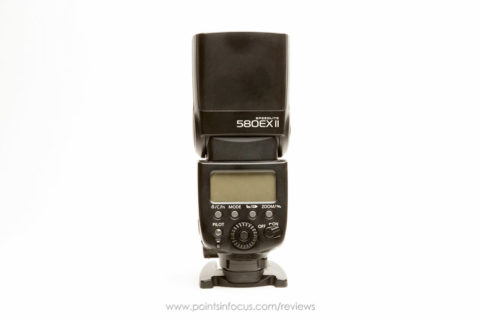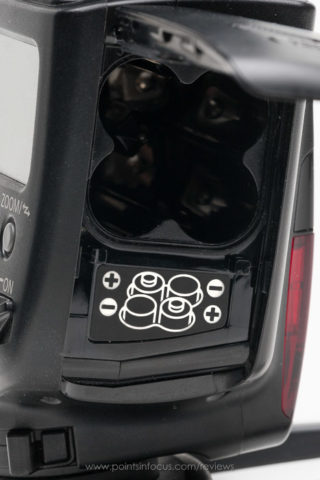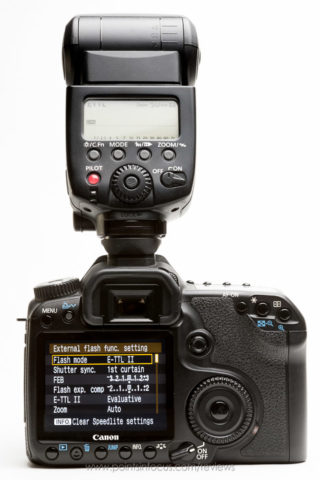Canon Speedlite 580Ex II Flash Review
Though it has been replaced by Canon, and even partially supplanted in my inventory, by the newer SpeedLite 600Ex-RT, the 580Ex II is still by far my workhorse flash. Of course, since it’s no longer available new, there seems little reason to review it or sing superlatives of it. However, as I tend to do with now discontinued products, I think there’s some merit in talking about the item in both the context of a used purchase and as well in general as a point of reference around it’s user interface and usability.
The 580Ex II introduced a number of upgrades over its direct predecessor the 580Ex, including improved dust and weather sealing, a metal foot, new locking mechanism, upgraded build, faster recycle times and the ability to control the flash’s settings through an in-camera menu (requires an EOS 1D mark III or newer). At the same time, the flash gained a little in size to accommodate its improved build quality.
Canon has since replaced the 580Ex II with the 600Ex-RT, and many of the advances that the 580Ex II made over the 580Ex have been carried over 680Ex as well as a number of refinements and improvements—but that’s a story for a different review.
The business end of the flash is a tilting panning power-zoom head, with a flip down wide-angle diffuser and a pullout catch light bounce card. Without the wide-angle diffuser, the zoom head provides coverage for the angles of view given by 24-105mm focal lengths on a full frame camera. The pop-down diffuser expands the flash’s beam coverage to cover a 14mm lens on a full frame camera.
The zoom position is controlled manually by tapping the zoom button on the flash and rotating the dial. The zoom settings are automatic, 24mm, 28mm, 35mm, 50mm, 70mm, 80mm, and 105mm. Manual zoom control is indicated by a boxed M next to the Zoom label. In auto, the flash will match the focal length of the lens on your camera, so long as the camera knows what that focal length is; adapted lens users will need to use the manual zoom.
Further, the 580Ex II is smart enough to deal with Canon’s various sensor sizes, and convert their focal lengths into flash head positions. So for example, if you’re using the 580Ex II on your EOS 7D with an EF-S 17-55mm f/2.8 IS USM, when you’re zoomed to 17mm, the flash will adjust to the “28mm” position to provide proper coverage and maximum power. This functionality can be disabled by changing custom function 09.
The variable zoom is the meat that gives the 580Ex II the ability to reach out to an ISO 100 guide number 58 meters (190.3 feet) at full power. For those not familiar with using guide numbers they follow the equation of GN = distance x f-number. For example, if you use the 580ex II at 105mm and full power (GNISO100 = 190.3ft) with an f/4 lens at ISO100, it will be able to fully illuminate a subject 47.6 feet away.

For bounce flash work, the zoom head itself can be rotated 180° to the left and right, 90° up, and 7° down for close up subjects (less than 6’ away). The zoom-head locks in two positions, the forward facing “normal” (direct flash) position, and the full up bounce position. To move the head from either of those positions, you need to press the bounce lock release button on the right side of the head. When rotating the flash head, there are click stops at 60°, 75°, 90°, 120°, 150°, and 180°, and when tipping the head vertically there are stops at 45°, 60°, 75°, and the locking position at 90°.
The lower housing is where power and controls are dominated by the controls on the back, battery bay on the side and AF illuminator on the front. The 580Ex II, like most flashes this size and power level, uses 4 AA batteries. The batteries load in a square configuration, though you have to be mindful of which direction the batteries are inserted and the orientations are show on a diagram just below the battery slot.

Serious users should prefer NiMH rechargeable as they provide more current and allow faster recycle times than standard alkalines. For the very serious users, an external high voltage power pack can be used via the power-port on the left side of the flash. Canon’s OEM solution is the Compact Battery Pack CP-E4, which takes 6 AAs in interchangeable magazines.
Most serious wedding and wildlife shooters, however, use one of the many battery packs available from Quantum Instruments (qtm.com) such as the Turbo 3 or Turbo SC. In either case, the external power pack provides high voltage electricity directly to the primary capacitor for faster recycling, while the internal AA batteries provide power for the control electronics.
One word of caution with respect to external power packs, though there is internal overheating protection built into the 580Ex II, it is still possible to melt or damage the plastic focusing lens when shooting rapid full power flashes. This is less of a problem when using internal batteries, as they simply can’t keep up with high frame rates for as long as an external high-voltage battery pack can.
One other note on power, it was fashionable in the past, and I’ve seen a couple of solutions recently, that use a 6V dry cell battery to power the flash though dummy AA batteries instead of just powered the flash capacitor though the high voltage port. If you were to go this route, and I don’t really recommend it, there are two things to be aware of. First, the battery compartment door on the 580Ex II is spring loaded pops open. Second is that the 580Ex II’s battery bay is gasketed for weather sealing, and by having the door open you break that seal.

On the front of the bottom part of the unit Canon has put all the sensory stuff. The two window (just under the text, is the optical remote sensor. The large area below that is the autofocus assist light, which emits a red AF grid that covers all the AF points on Canon’s pro bodies prior to the EOS-1D X. Finally, in the small recess is the auto flash light meter sensor that is used when the flash is set to auto flash mode.
The new metal foot is an upgrade over the plastic one on the 580Ex, it’s also surrounded by a rubber weather seal that keeps the entire hotshoe dry in damp or dusty environments. The other major change to the shoe is the replacement of the old style screw down lock with a faster lever action lock.
The rear control panel is pretty standard for a higher end hotshoe flash; a big fixed segment LCD panel that shows the settings, power levels, distances, and so forth, below that an array of buttons and dials to affect those settings, and finally an indicator light and power switch. Though the UI is pretty standard for a flash, Canon’s move to improve weather sealing, and the use of the lever-action lock on the foot, did make the system a little less friendly than the 580Ex predecessor.
The improved weather sealing dictated that the old style toggle switch couldn’t be readily used. It was replaced with a rotating lever style switch that kept the 2 positions (on and off).
The other apparent casualty of the weather sealing and flip lock foot was the easy to use off/master/slave wireless mode select switch. Unfortunately, this is probably one of the biggest UX rubbing points with the 580Ex II. Instead of simply flipping a switch to access the wireless remote functionality, you must hold the zoom button down for 2 seconds or more and then rotate the main dial.
This brings me to Canon’s wireless flash system. Canon’s optical wireless system, in my opinion, works but isn’t especially great. For starters, since it’s optical the range is limited and obstructions can impare the ability for flashes to see the command signals. On top of that, there are 4 channels, which separate which flashes are fired by which master; meaning up to 4 photographers using the optical flash system can work in an environment without firing each other’s flashes. Finally, flashes are organized into 1 of 3 groups (A, B, or C). The real kicker to me is the way Canon elected to control flash powers.
Manual master mode works the way you’d expect it to, the powers for each of the 3 groups can be set manually. In TTL mode, however, the situation becomes some was less flexible. Instead of allowing you to change the exposure compensation of each group independently, the first two groups (A and B) are linked by a ratio. This in turn pretty much fixes groups A and B as key and fill lights in a typical lighting setup, while group C retains flexibility in being a back or hair light or anything else.
According to Canon:
The total flash output of groups A and B is set to provide correct exposure. The pre-flash is fired by the slave groups in sequence. The readings obtained are used to set each slave group’s flash output in accordance with the flash ratio.
For example, if the A:B ratio is set to 2:1, the flash output of slave group B will be one stop lower than that of slave group A, but together they give a well-exposed image.
In some respects, the ratio system makes some sense. Personally, the ratios are one area I never really got my head wrapped around. I vastly prefer using my TTL PocketWizards and the AC-3 zone controller, giving me 1/3 stop exposure compensation for each channel respectively, or simply manual flash control which isn’t subject to the A:B group ratios.
Aside from the A:B ratio the two biggest short comings I see in Canon’s wireless systems are the lack of a manual slave mode, and the inability to change the zoom position remotely. Sure using a 580ExII as a manual optical slave isn’t the best way to spend money, but the hardware clearly has the functionality detect a flash pulse and trigger on in and in a pinch, it can be a useful feature to have.
Quiet possibly the biggest problem with a complicated flash system, is expressing that functionality in a way that’s easy and obvious to access. Unfortunately, the fixed segment display and minimal buttons makes that a more problematic experience.
In wireless master mode, for example, pushing sel/set button (in the middle of the dial) rotates through flash exposure bracketing, flash exposure compensation, group A:B ratio, group C exposure compensation and then it starts all over again. Likewise, pushing the zoom/remote button cycles though the zoom position, channel, and ratio setup. To adjust any given setting in either of those progressions you stop turn the dial, then have to resume the button pushing to move on.

Fortunately, single flash operation is considerably easier. Custom function 13 allows the flash exposure compensation to be set by merely turning the dial. Better yet, a number of Canon bodies will let you change the flash exposure compensation easily from the camera without having to touch the flash. Regardless of how C.Fn-13 is set, pressing the set button will cycle through flash exposure compensation and flash exposure bracketing.
The rest of the controls are fairly straightforward. The Mode button cycles the flash though the available flash modes: E-TTL/TTL/Auto (depending in how C.Fn-5 is set), manual, and multi or stroboscopic. The button between the mode and zoom buttons cycles the flash though first curtain sync (default), high-speed sync, and rear/second curtain sync.
Finally, the pilot light can be pressed to test fire the flash, and will light to indicate the readiness of the flash; red for flash read, green for quick flash ready if quickflash has been enabled though the custom settings.
Rounding out the package, the 580Ex II does come with a small stand (what it’s depicted sitting on in all the pictures accompanying this article), as well as a soft case.
So where does the 580ex II stand now that it’s been replaced. Used and in good condition, they seem to be going for about $100 less than the 600Ex-RT. Not a lot of savings, really, even if you don’t need the extra features of the 600Ex. Then there’s the competition from the Taiwanese and Chinese knock offs, many of which now offer wireless slave capabilities, including TTL metering, and cost a whole lot less. Sure they’re not built as well, but when you’re paying less than $200 (often more like $100) for the flash, instead of $400 you can afford to trash a couple of flashes before you’re on the wrong side of that deal.
In the end, as much as I like my 580Ex IIs, I simply don’t see a point in buying into one used at this point. For someone who just wants more flashes, or just wants a powerful flash cheap, one of the sub $200 clones is probably a better deal. On the other hand, a 600Ex-RT isn’t that much more expensive than a used 580Ex II in good condition, and does have the much better RF remote flash implementation.
Specifications
| Flash Head | |
| Guide No.: | 58m /193ft (at 105mm coverage, ISO 100) |
| Flash Coverage: | 24-105mm, 14mm with wide angle panel |
| Bounce: | +90°/-7° (up/down); 180°/180° (left/right) |
| Flash Duration | Normal: 1.2ms or less Quick flash: 2.3ms or less |
| Color Temp information: | Tells camera in AWB mode that a flash is being used |
| Display | |
| Type: | LCD |
| Size: | ~48 x 23 mm / 1-7/8 x 7/8 in |
| Back-light: | Yes, green |
| Exposure Control | |
| Exposure Modes: | E-TTL II, E-TTL, TTL autoflash, auto/manual external flash, manual flash, stroboscopic |
| Effective Flash Range: (50mm f/1.4 @ ISO 100) |
Normal Flash: 0.5 – 30m (1.6 – 98.4 ft.) Quick Flash: min 0.5 – 7.5m (1.6 – 24.6 ft.) max: 0.5 – 21m (1.6 – 68.9 ft.) High Speed Sync: 0.5 – 15m (1.6-49.2 ft.) |
| Flash Exposure Compensation: | ±3 stops in 1/3- or 1/2-stop increments |
| Flash Exposure Bracketing: | ±3 stops in 1/3- or 1/2-stop increments |
| High Speed Sync: | Yes |
| Manual Flash: | 1/128 – 1/1 in 1/3 stop increments |
| Stroboscopic flash: | 1-500 Hz (1-199 Hz during optical wireless shooting) |
| Modeling Flash: | Stroboscopic pulse when DoF preview button is pressed |
| Recycling Times | |
| Normal Flash: | 0.1 – 5 seconds |
| Quick Flash: | 0.1 – 2.5 seconds |
| Read indicator: | Red: normal flash available Green: quick flash available. |
| AF Assist Beam | |
| AF Coverage: | All 45 points for 28mm or longer focal lengths. |
| Range | At center: 0.6 – 10m (2 – 32.8 ft.) At edge: 0.6 – 5m (2 – 16.4 ft.) |
| Optical Transmission Function | |
| Wireless Settings: | Master/Slave |
| Channels: | 1 – 4 |
| Slave control: | Up to 3 groups (A – C) |
| Range: | Indoors: ~15m (49.2 ft.) Outdoors: ~10m (32.8 ft.) |
| Power | |
| Internal Power: | 4 AA/LR6 aklakine, NiMH or Lithium batteries |
| Flash Cycles: | ~100-700 flashes with AA/LR6 alkaline batteries |
| Optical Transmission Time: | ~1500 times with master flash off |
| Power Saving: | Power off after 90 sec. of idle operation Power off after up to 60min of idle operation as slave |
| External Power: | Yes, CP-E4 battery pack or similar. |
| Dimensions & Weight | |
| Dimensions: | 76 x 127 x 117 mm / 3.0 x 5.4 x 4.6 inches |
| Weight | 405g / 14.3 oz (not including batteries) |
Comments
How can the bracket mounting screw socket be used? I’ve seen it on other flashes, but haven’t seen it in action.
You’ve got me there. Like you, I’ve never actually seen it used or used it.